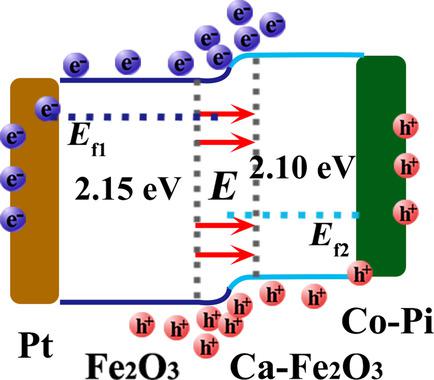当前位置:
X-MOL 学术
›
ChemSusChem
›
论文详情
Our official English website, www.x-mol.net, welcomes your
feedback! (Note: you will need to create a separate account there.)
3D Branched Ca‐Fe2O3/Fe2O3 Decorated with Pt and Co‐Pi: Improved Charge‐Separation Dynamics and Photoelectrochemical Performance
ChemSusChem ( IF 7.5 ) Pub Date : 2019-06-26 , DOI: 10.1002/cssc.201901331 Dong Chen 1 , Zhifeng Liu 1, 2, 3 , Zhengang Guo 1, 2 , Mengnan Ruan 1, 2 , Weiguo Yan 2
ChemSusChem ( IF 7.5 ) Pub Date : 2019-06-26 , DOI: 10.1002/cssc.201901331 Dong Chen 1 , Zhifeng Liu 1, 2, 3 , Zhengang Guo 1, 2 , Mengnan Ruan 1, 2 , Weiguo Yan 2
Affiliation

|
The construction of junctions on hematite is an effective way to overcome the problems of slow charge separation and transfer kinetics, but constructing the junction is a significant challenge in photoelectrochemical (PEC) water splitting. Herein, a considerable improvement in PEC performance for α‐Fe2O3 was achieved following the introduction of a p–n homojunction between n‐type α‐Fe2O3 and p‐type Ca‐doped α‐Fe2O3 through a facile hydrothermal method. The resultant 3D branched Ca‐Fe2O3/Fe2O3 enhanced the absorption intensity and reached a photocurrent density of 2.14 mA cm−2 at 1.23 V vs. reversible hydrogen electrode (RHE). The merit of the desired lattice matching of the buried p–n homojunction structure built an internal electric field, which led to appropriate band alignment. These results were supported by a series of photoelectrochemical measurements, in particular, surface photovoltage (SPV) measurements. For further improvement of the charge‐separation efficiency, a combination of separated cocatalysts was established on the homojunction structure, in which Pt acted as the electron collector and was deposited on the bottom, and Co‐Pi as the hole‐extraction cocatalyst was inserted to accelerate hole transfer on the surface of the photoanode. The resulting Co‐Pi/Ca‐Fe2O3/Fe2O3/Pt branched nanorods showed a significant improvement in charge‐separation efficiency and photocurrent density (2.94 mA cm−2 at 1.23 V vs. RHE). The present strategy, both the construction of the p–n homojunction and the coupling electron‐ and hole‐transfer cocatalyst, could be expanded to many unstable or low‐efficiency semiconductors for the design and fabrication of cost‐effective photoanodes in PEC water splitting.
中文翻译:

用Pt和Co-Pi装饰的3D支化Ca-Fe2O3 / Fe2O3:改进的电荷分离动力学和光电化学性能
在赤铁矿上构造结是克服缓慢的电荷分离和转移动力学问题的有效方法,但是构造结是光电化学(PEC)水分解中的重大挑战。这里,在对PEC性能相当大的改进的α-Fe 2 ö 3达到以下引进AP-n的n型之间同质结的α-Fe的2 ö 3和p型的Ca掺杂的α-Fe 2 ö 3通过简便的水热法。生成的3D支化Ca-Fe 2 O 3 / Fe 2 O 3增强了吸收强度并达到2.14 mA cm的光电流密度相对于可逆氢电极(RHE)在1.23 V时为-2。埋入的p–n同质结结构的理想晶格匹配的优点是建立了内部电场,从而导致了适当的能带对准。这些结果得到一系列光电化学测量的支持,尤其是表面光电压(SPV)的测量。为了进一步提高电荷分离效率,在同质结结构上建立了分离的助催化剂的组合,其中Pt用作电子收集器并沉积在底部,而Co-Pi作为空穴提取助催化剂被插入加快光电阳极表面上的空穴传输。生成的Co-Pi / Ca-Fe 2 O 3 / Fe 2 O 3/ Pt分支的纳米棒显示出电荷分离效率和光电流密度(在1.23 V时为2.94 mA cm -2与RHE相比)的显着改善。目前的策略,即PN同质结的构造以及耦合的电子和空穴转移助催化剂,都可以扩展到许多不稳定或低效率的半导体中,以设计和制造PEC水分解中经济高效的光阳极。
更新日期:2019-06-26
中文翻译:

用Pt和Co-Pi装饰的3D支化Ca-Fe2O3 / Fe2O3:改进的电荷分离动力学和光电化学性能
在赤铁矿上构造结是克服缓慢的电荷分离和转移动力学问题的有效方法,但是构造结是光电化学(PEC)水分解中的重大挑战。这里,在对PEC性能相当大的改进的α-Fe 2 ö 3达到以下引进AP-n的n型之间同质结的α-Fe的2 ö 3和p型的Ca掺杂的α-Fe 2 ö 3通过简便的水热法。生成的3D支化Ca-Fe 2 O 3 / Fe 2 O 3增强了吸收强度并达到2.14 mA cm的光电流密度相对于可逆氢电极(RHE)在1.23 V时为-2。埋入的p–n同质结结构的理想晶格匹配的优点是建立了内部电场,从而导致了适当的能带对准。这些结果得到一系列光电化学测量的支持,尤其是表面光电压(SPV)的测量。为了进一步提高电荷分离效率,在同质结结构上建立了分离的助催化剂的组合,其中Pt用作电子收集器并沉积在底部,而Co-Pi作为空穴提取助催化剂被插入加快光电阳极表面上的空穴传输。生成的Co-Pi / Ca-Fe 2 O 3 / Fe 2 O 3/ Pt分支的纳米棒显示出电荷分离效率和光电流密度(在1.23 V时为2.94 mA cm -2与RHE相比)的显着改善。目前的策略,即PN同质结的构造以及耦合的电子和空穴转移助催化剂,都可以扩展到许多不稳定或低效率的半导体中,以设计和制造PEC水分解中经济高效的光阳极。


















































 京公网安备 11010802027423号
京公网安备 11010802027423号